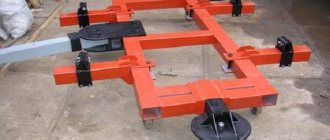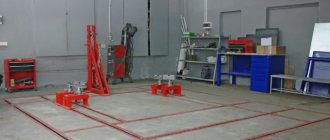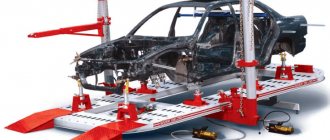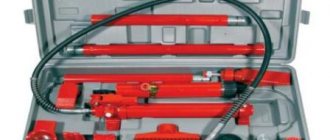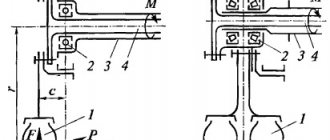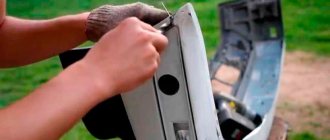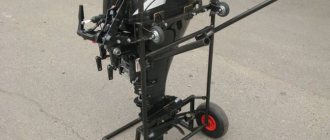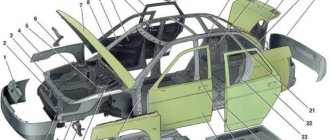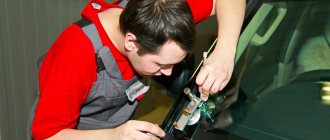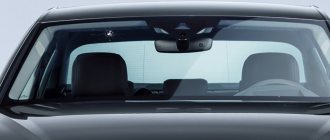Home / Accessories and parts
Back
Reading time: 2 min
0
720
This device is very common. He works with both car enthusiasts who trust themselves to repair their cars, and private repairmen. At many service stations, straightening work is carried out by a spotter.
Small size and the ability to correct body damage are the main purpose of the tool. Therefore, the spotter has practical applications in various fields.
In this article we will describe the principle of operation of the spotter, its properties and the method of assembly from a welding machine. Let's compare the advantages of a hand-assembled device and its characteristics relative to factory products.
- Description and characteristics of the spotter and working with it
- Spotter assembly
- How to assemble a starting device?
- Make it yourself or buy a factory one?
- Conclusion
What is a spotter and how does it work?
In traditional spot welding technologies, the workpieces to be welded are located between two oppositely placed electrodes, which, when closed, form an electrical circuit. Its energy power is sufficient for local melting of the metal and the formation of a welding point (spot).
The body repair spotter is not a two-point, but a single-point portable welding machine. For this purpose, one of the contacts of the device is connected to the structure being restored (“ground”), and the second is included in the spotter circuit. Depending on the circuit, spotters are divided into inverter and transformer ones, with industrial designs most often using a transformer circuit, and homemade ones using an inverter circuit.
Spotter components:
- Pneumatic pliers, with the help of which the welded elements are pressed. In some versions of spotters, the pincer clamps act as electrodes.
- A set of fastening devices - loops or wire clamps (hooks for a spotter), as well as consumables, in particular, replaceable electrodes of different diameters.
- Reverse hammer that performs straightening.
- Device for indicating and monitoring the progress of the process.
- Connecting copper cables in insulating braid.
Some manufacturers of spotters increase their functionality by equipping the device with a puller - a straightening device that allows you to mechanically straighten local defects on the surface of products up to 2...2.5 mm thick. The spotter puller can have a mechanical or lever clamp.
This is how the spotter works. In single-sided designs, the parts to be welded are attached to each other with hooks or loops, after which the inverter/transformer is turned on and electric current is supplied to the closed circuit. Its limit value is adjusted depending on the tasks. If you only need to perform straightening, the heating of the surface should not exceed 780...850ºС, at which the metal already begins to soften intensively, and the rate of scale formation is still low. For spot welding, you will need to bring the temperature at the contact (contacts - for double-sided spotters) to 1500...1550ºС.
When the connection point is heated to the specified temperature, straightening is performed using a reverse hammer, puller or spotter clamp. After forming the connection, the gun is removed from the welding site, the current is turned off, the pliers are unclenched, and the quality of the operations performed is checked.
https://www.youtube.com/watch?v=cw2B_tMmvjw&t=177s
Unit design properties
The device consists of components such as a box, a gun, a cable, and an electrode.
The box contains the entire apparatus system that is necessary for welding . In order to carry out body work clearly and quickly, you must adhere to the order and technology of the process.
If the surface has undergone deformation, it must be cleaned of any coating. It could be rust, paint or varnish. This stage is very important, since the quality of the metal connection directly affects the outcome of the entire process. Contacts are attached to the surface that has been adjusted. A fastener is welded onto the cleaned area of the damaged area, to which the device in question is connected.
Read also: Welding equipment with acetylene and oxygen
Following this, the device is grabbed with a gun, after which the dent is pulled out. For leveling, they resort to using a hammer, hydraulic cylinders and other devices. Pay attention to the thickness of the metal. Here you should understand what equipment will make it possible to straighten the machine so as not to cause harm to it. The back hammer is not used in combination with aluminum. In addition, not every unit can cope with a galvanized body. When the body straightening is completed, the welded part is twisted. The contact area is cleaned with a grinding machine.
How to work as a spotter
Working as a spotter, auto straightening has been perfected by many specialists, but the technique is not particularly difficult for beginner straightening artists. Using the device, it is possible to level out a dent in any area, regardless of location.
The electrode receives current from the welding machine, thus making a connection to the deformed area. For straightening, a reverse hammer is used, which can be replaced with a special stop. Mechanical influences continue until the surface is completely leveled. After completion of the work, the area is cleaned, as slag from the electrode remains on it.
To learn how to use a spotter, you don’t need to go to special courses
Algorithm for using a spotter for straightening:
- Surface preparation. Regardless of the body material (aluminum or iron), all coatings are removed from the surface: paint layer, putty, primer.
- Connection "minus". A negative terminal is connected to the body for grounding.
- Installation of fasteners. The clamps (any hooks, loops or hooks) are welded to the deformed area of the body. Spot welding is used for connection.
- Tool preparation. The main tool is coupled and auxiliary structures are prepared. It is convenient to use a puller - a device to facilitate the restoration of parts.
- Editing a detail. Pulling out the body element until the original appearance and shape is restored.
- Removing fasteners. A grinder is suitable for removing the clamps.
- Grinding. The final stage is cleaning the surface and preparing for painting.
Removing small dents
There are several fundamental differences between the alignment of small and large-scale dents:
- only one hook is fixed for pulling;
- cleaning is carried out exclusively on the deformed area, the rest of the paintwork is not touched;
- the part is covered with masking tape around the perimeter to prevent paint destruction;
- It is recommended to perform straightening carefully, without applying strong force, to avoid deformation of the entire part.
The operating algorithm remains the same, but additionally small attachments are used.
If we compare a regular welding machine, we can say that the spotter is much safer, since it does not produce sparks and does not heat up the metal
Dealing with serious damage
Repairing major damage will require extensive work:
- many fasteners are welded along the dent, mainly in places of the deepest damage;
- each element should be pulled out a little - and so on in a circle until complete restoration. If you immediately level one section, at the time of straightening the second, the condition of the previous place may be disrupted;
- A relatively large reverse hammer will come in handy, but strong impacts should still be avoided, otherwise there is a risk of damaging the fastening of the body element.
Transformer production stages
Assembling the transformer is a mandatory step in the manufacture of a spotter from a welding machine. This kind of work is the most difficult. Winding requires a lot of time, but this step is not necessary. The winding is carried out on a ring iron. The wire for the secondary winding should be made of aluminum or copper. High-quality insulation should be laid between the coils. Transformer paper in several layers is suitable for this. For maximum reliability, it is impregnated with paraffin.
The pistol is made from a semi-automatic machine . It will require some additions to secure the tool to the drawing device. To make pliers, a simple 20 by 20 mm pipe will do. The power wires connecting the transformer and the gun must have an identical cross-section. Alternatively, they must exceed the tire cross-section. Do not use wires that are too long. Their maximum size should be 2.5 m. The operating cable connecting the transformer and the gun should be made on the basis of a thermally insulated commutation cable. Each time it is heated, this layer will shrink.
Tool
Do-it-yourself car body straightening is done using special tools. Their list includes:
- Straightening hammers and mallets. They are used to remove dents of various shapes and complexity. The impact head of the hammer is well polished and has a rounded surface. The tool is made of alloys of non-ferrous metals, plastic or rubber. The weight of the impact device does not exceed 200 grams. Damage to the body is eliminated using frequent gentle blows; depending on the depth of the dent and the type of metal being restored, the defect is tapped either from the edge to the center, or vice versa.
- Supports, anvils, stamps. The main purpose of this set of tools is to fix the damaged area of the body. When choosing a specific tool, they are guided by the shape and size of the dent. Depending on this, the substrate is chosen.
Backing dies, supports and anvils. Fix the damaged area of the body
It is important to consider that the shape of the support must match the shape of the damaged area. Impact blades and spoons. In addition to pulling out dents, these devices are used as impact stamps to repair serious damage.
When compressing metal sheets, spoons are used. They separate the defective areas. Levers and hooks. Devices designed to pull out a defect from the inside. The body stiffeners are used as a support for the lever. Depending on the shape and size of the dents, hooks of appropriate sizes and shapes are used. Files and sander. Level the restored surface before painting and polishing the painted area. Spotter. A device designed to perform spot welding. Used to eliminate tears and creases in metal.
If you have certain skills, abilities and the necessary set of tools, you can restore damaged areas of the body yourself. However, if there are no conditions for straightening, it is recommended to contact specialists, since the result of self-repair may be worse than expected.
Functionality of serial model spotters
Before designing and making a spotter with your own hands, it will be useful to study the functionality of industrial models. They do:
- welding of repair washers;
- welding of a rod that straightens dents with a rod;
- heating the metal for its precipitation using graphite electrodes;
- ventilation and overheating protection system with activation after cooling.
- switching between continuous operation for heating and short-term operation for welding
The devices from the store are reliable and easy to use and maintain. Special training for the operator of such a device is not required; general welding and plumbing skills are sufficient.
Spotter: what is it and why is it needed?
Work related to straightening a car does not always come down to basic skills in working with tools. Accuracy and knowledge of the design and geometric features of body parts are often required. Even if you have the knowledge, you will need an auxiliary, specialized tool, which is a spotter. What is a spotter and how it works, we will consider further.
What is a spotter and how does it work?
Spot welding is used to connect parts made of thin sheet metal to each other, as well as to fix various fastening and supporting elements on them. Welding is carried out with a short and powerful current pulse. This ensures that the metal sheet does not penetrate to the full depth and thus avoids damage to its surface on the reverse side. Therefore, the power sources of many spotters have an open circuit voltage of 6÷8 V, a welding voltage of 1.5÷2 V and a pulse current of the order of 2500÷3000 A, which allows welding on a metal sheet with a thickness of 0.5 to 1.5 mm.
This apparatus for straightening body parts includes five main components (see figure below):
- power supply with a relay or electronic control and regulation unit;
- welding cable with control wires;
- ground cable with plate;
- a gun with terminals for connecting the power and control circuits and a threaded connection for electrodes;
- set of electrodes, accessories and consumables.
- Cleaning the dent surface.
- Welding outside the working area of the ground cable plate.
- Installing an electrode into the gun and clamping fasteners into it (ring, nail).
- Welding fasteners to the exhaust area with a short pulse.
- Pulling out a dent in a body part manually or using devices.
- Boiling fasteners from the metal surface.
Methods of working with a spotter
The principle of operation of the device for straightening dents in those places of the body, which cannot be approached from the reverse side without serious disassembly of the upholstery or structures and components of the car, is based on pulling out the dented area of the surface by a temporarily welded fastener - a mounting washer or a metal rod. The force created by the reverse hammer is directed from the inside of the body to the outside of the dented surface, simulating blows with a mallet from an inaccessible place.
Do-it-yourself spotter at work
The technological process can be divided into the following operations:
- Remove paint, soil and dirt from the center of the dented area of the body - it must be stripped down to bare metal.
- Connect the ground of the spotter to the car body. The vehicle battery must be disconnected and the ignition turned off to avoid damage to electrical equipment from welding current pulses.
- Spot weld the fasteners to the center of the dent.
- Straighten out the dent by pulling out the metal by the fastener.
- Using a twisting motion, remove the fasteners from the leveled surface.
- Clean the place where the washer or electrode is attached and prepare the body element for painting.
To work with a spotter, store-bought or home-made, the master will only need general welding and plumbing skills. It is necessary to comply with industrial safety requirements in order to avoid harm to human life and health and damage to material assets.
Main components for assembly
To assemble and test a homemade spotter, you need the following components and consumables:
- Frame. Sheet metal box structure with front and back panels. Ventilation holes and a ground terminal are required.
- Power supply. In its simplest form, it is a do-it-yourself transformer with a circuit breaker in the primary circuit.
- Power cables. The welding cable must have a terminal for connection to power and a threaded contact for connection to the gun, and the ground cable must have a terminal and contact pad for welding connection to the body part.
- Control circuit. The minimum version includes a switch button on the gun, an input voltage cut-off relay, control wires and a control circuit power supply.
- Welding gun. At one end there is a contact threaded connection for connecting electrodes and adapters, and at the other there is a socket for connecting a welding cable.
- Equipment. The basic version includes electrodes for washers and pins, a return hammer and an adapter for connecting a carbon electrode.
Assembling a reverse hammer (inopuller) with your own hands
In order to assemble a reverse hammer with your own hands, you need the following parts:
- steel rod 60 cm long, 17 mm in diameter, with threads on both ends;
- steel bushing with a through hole with a diameter of 15 mm, a length of 15 cm and a diameter of 40 mm;
- return spring;
- travel stop nuts and washers;
- adapters for attaching electrodes.
First, a washer is put on the end of the rod intended for fastening into the gun and the nut is tightened tightly. The rod is then passed through the bushing and return spring. The final step is to attach a washer and nut to the bottom threads, and then screw on the electrode adapter. During operation, the massive bushing will be repelled by the spring and perform reciprocating movements between the two washers.
Making a working pistol
Branded spotter pistols are usually produced in the form of devices with a pistol grip. Much of what folk craftsmen make with their own hands can only conditionally be called a “pistol.” Often it is just a cylinder with a button and a terminal for connecting a cable at the end. This is because the spotter gun consists of only three parts: the body, the contact rod and the switch. The contact rod is usually made of brass. At one end there is a thread for attaching a reverse hammer, and at the other there is a clamp for connecting power. For those who make such devices with their own hands, whether to place it in a pistol case or use it as is is a matter of personal preference. At the same time, despite the low welding voltage, it must be insulated: these are the requirements of safety regulations.
Transformer for spotter
Any transformer is suitable for making a power source for a spotter. Videos of the manufacture of spot welding machines based on transformers of microwave ovens and other household appliances are distributed on the Internet.
At the same time, the authors of these crafts do not inform what current their devices are designed for, and this is very important, because
The penetration of the metal surface during operation of the spotter should occur in a fraction of seconds, without appearing in any way on the back side of the part. Factory devices have a power of 3÷5 kW with an open circuit voltage of 7÷8 V (welding voltage - 1.5÷2 V).
For a spotter assembled by yourself and intended only for body repairs, a power of 1.5÷2 kW is sufficient. It is not difficult to calculate how many turns there should be in the secondary winding of a transformer. To do this, the number of turns of the primary winding (new) must be divided by the quotient of 220 divided by 7 ÷ 8. Usually it turns out just a few turns.
Control unit diagram
There are quite a lot of electronic circuits on the Internet that are labeled as spotter control units. Some of them refer to industrial designs of spot welding installations (including old ones), others are replete with electronic components and have redundant parameters, and a number of circuits are not at all related to our topic. Many of the proposed devices implement adjustments to the open circuit current and voltage, as well as control of the duration of the welding pulse. Their manufacture requires a certain skill, and the parts used are not that cheap. Choosing one of these schemes is advisable if you plan to make a spotter for commercial use in a small auto repair shop. And for devices that are made by hand and used at home, there are simpler solutions.
DIY manufacturing algorithm
To make the unit yourself, you need some skills and an understanding of the basics of working with such equipment. You can make a spotter from a welding machine yourself in accordance with the drawings. To do this, you need to carefully study the design features of the device. You can use available parts.
It is not always advisable to purchase a factory-made device. A quality unit can cost a pretty penny. It is necessary to consider the configuration of the device and its drawings.
Equipment from inverter apparatus
Most often, an inverter-based unit is made using homemade material. The main components of the device are a thyristor relay and a welding inverter. To assemble the device you will need:
- thyristor with an indicator of 200 Volts;
- transformer to step down 122 volts to control the relay using a button;
- relay with a power of 30 amperes;
- diode bridge;
- button for control and monitoring;
- contact group 220 volts.
The transformer is connected using a diode bridge. The relay thyristor is connected to it. The transformer powers the control branch of the circuit. Before making a spotter with your own hands, you need to ensure safe working conditions. For this purpose, rubber mats are placed under your feet and standard safety regulations are followed.
Main assembly steps
To make a homemade unit, a Nordic welding machine is ideal. It is necessary to be able to change the configuration of the device so that the DC spotter outputs 1500 amperes, at a minimum. Assembly is carried out according to the following rules:
- Remove the secondary layer from the apparatus. Sometimes there are several of them.
- Before installation, determine the number of turns per 1 Volt. For this purpose, the primary winding is wrapped in copper wire. Then the Volt indicator is measured.
- The resulting figure is divided by the number of turns. The result will indicate the number of turns per volt.
- The secondary layer that has been removed is used to produce a tire. It is advisable not to allow this parameter to fall below 160 square mm.
- The voltage should be 6 volts. If the cross-section is smaller, you can divide the tire into several parts. They are secured with insulating tape.
The number of fragments depends on the initial indicators. Let's say if the parameter is 40 sq. mm., the tire breaks into 4 parts. You need to take two tires wrapped with electrical tape or adhesive tape for painting work. Isolation must be consistent. First there is a layer of insulating tape, then adhesive tape, and insulating tape is wound on top. Rivets can be installed on open areas.
The resulting busbars are moved to the transformer. This process is not easy and requires certain skills. A hammer and an additional assistant are required. Thanks to this, the tire will fit better and will not suffer any damage. If the power indicator is normal, then the device can be considered ready. If not, you will have to conduct a series of experiments by connecting wires to the primary winding.
Main types of straightening
Many car owners are sensitive to body damage resulting from:
- random collisions;
- collisions with obstacles;
- throwing stones from under the wheels of passing and oncoming cars;
- a number of other reasons.
Dents can be corrected in various ways. The process of restoring the surface of deformed body parts is called straightening. With its help, you can return the appearance of the car to its original shape. Straightening refers to the final stage of body restoration work and requires a careful, careful, professional attitude.
Depending on the type of damage, various straightening technologies are used
With minimal plumbing skills, many damages to body parts can be repaired yourself. The straightening technology should be selected taking into account the make and year of manufacture of the car. The bodies of Soviet Volgas, Moskviches, Zaporozhets, etc. were made of durable tin, which was very difficult to restore to its original form. Gas welding work was often required, a skill that not all drivers possessed. In modern cars, thin plastic steel sheet is used for body parts, which is easily restored by extrusion, tapping, vacuum and other methods. Therefore, most car owners can handle simple body work on their own. The following types of manual straightening are distinguished:
- Removing dents. This is the most common type of straightening. Various technologies are used to eliminate dents.
- Elimination of bulges. Bulges are formed as a result of body parts bending during impacts and collisions. They are eliminated by frequent and gentle blows of a hammer through the substrate. In difficult cases, a gas burner is used. Heating is carried out in a spiral from the center to the edges of the convexity.
- Local straightening. The original shape of the part is restored without dismantling it. However, it is often necessary to remove handles, trim, lights and other elements that interfere with the work from a damaged door, fender or hood.
Hooks, levers and other devices
For a straightener who is working to give a deformed body its original shape, the following will also be useful for performing the full scope of repair work on car surfaces:
Special hooks.
Straightening hooks must be made of metal with a thickness of at least 10-12 mm.
Convex, elastic, stretching, leveling, universal spoons.
Spoon-like tools bend and pull out hard-to-reach (internal) parts of the body.
Other levers for contact repairs.
Levers are used where ordinary human effort is not enough.
Car straightening and straightening is carried out starting with the largest dent, using suitable tools, while straightening hammers remain the main straightening device.
Hydraulic body repair is used to straighten depressed parts of an untrimmed car body. Using a pump with all kinds of straight and shaped nozzles, equipped with cylinders and operating on a hydraulic mechanism, a vacuum extractor of car dents is carried out. If it is not possible to straighten using pumps, clamps and grips can be useful. Straightening kits usually include several of these clamping devices of different sizes (diameters). The grips also differ in the number of fasteners (there can be from 1 to 3 pieces) and the method of fixation (the most common method of fastening to the body is with a screw).
Pneumatic hammers are used for high-quality straightening of hard-to-reach areas of the car. Also, to perform particularly complex straightening work, there are special metal mechanical units that have several supports (from two to four), between which a lowering and rising rod is fixed. It is inserted into a pre-made hole in the part of the body where pulling is required. Fasteners are usually used along with the rod on such a device.
Before starting straightening work, you should, after inspecting the damage to the car, select from a variety of special tools those that will help in the case in question. For minor damage, a home straightening kit is suitable; for straightening deeper dents, you should seek the help of specialists from an auto repair shop.
How to choose a spotter?
There are the most important criteria that influence the cost of a spotter:
- converter type. Inverter ones are less common, but they perform well in spot welding. Transformer ones are more often used, since they are more reliable and cheaper;
- performance. There are models of standard power indicators; they are applicable only for straightening individual body elements. Higher power options are used for spot welding and work on stronger parts;
- type of weld formation. The simplest option is welding on one side using an electrode. A device with double-sided welding is more efficient and more expensive; it is performed with special pliers that open from the back side manually or pneumatically and immediately create a hook.
Choose
Repair by a spotter has a narrow specialization. Apart from the car service industry, it is practically not in demand, except in rare cases of repairing damage to the body of household appliances.
Today, the Russian spotter market includes more than a hundred models from different manufacturers, differing in power, price, and operating parameters. Of these, three main ones:
- Devices made in China, Japan, South Korea.
- Devices from Western European manufacturers.
- Domestic devices.
The lower and middle price groups are represented mainly by Chinese instruments. Their advantages include the tendency of increasing quality at a stable price. If relatively recently the purchase of a Chinese instrument was justified by its cheapness, today even professionals buy it. Of the domestic devices, there is the Russian “Spotter Pilot” line. The company produces products in both the household and professional segments. It has a number of patents and supplies products to the markets of Canada, the USA and Europe. European manufacturers are leaders in the segment of professional models. In many respects, superior to similar Chinese and domestic models, the devices are distinguished by build quality and successful ergonomics. A significant disadvantage is the high cost.
When choosing, pay attention to consumables. Typically, Chinese spotter models for spot welding are more fully equipped, however, as a rule, in order to save money, some of the electrodes are not copper, but copper-plated, which reduces the service life
For serious professional body repair work, it is better to choose a model from European or domestic devices of the corresponding class.
